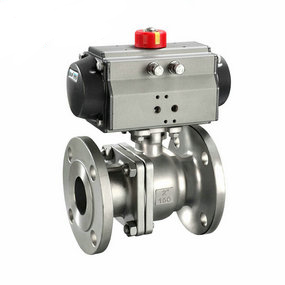High temperature resistant pneumatic three-way butterfly valve Maintenance and treatment of corrosion-resistant pneumatic ball valve The use of corrosion-resistant pneumatic ball valve shall specify the applicable medium and scope, and select appropriate materials and gaskets for production. Before the maintenance of the pneumatic ball valve, the upstream and downstream pipeline pressure must be removed before disassembly. The disassembled parts can be cleaned by immersion. The non-metallic parts shall be taken out of the cleaning agent as soon as possible after cleaning, and shall not be soaked for a long time. The online maintenance of pneumatic ball valve requires the operation of a qualified leak stoppage engineer under pressure, and the maintenance steps can refer to Xinqing Environmental Protection's Pneumatic Ball Valve Leak stoppage Operation Manual under Pressure.

Structure of Elastic Sleeve Compensator and Energy Saving Analysis of Spherical Compensator
There are various types of compensators in the elastic sleeve compensator series. Of course, different compensators have different structures, different effects, different places of application, different costs, etc. Today we will talk about the differences between sleeve compensators and sleeve compensators.
1. First, let's talk about the overall advantages of the elastic sleeve compensator. Technically, it adopts a non-traditional principle completely different from other compensators. The pressure and sealing force are separated to form a cylindrical sealing structure. The sealing data can theoretically be used in the whole 1000 ℃ temperature difference, that is, - 200 ℃~800 ℃ environment. This product adopts the most scientific sealing structure. By reducing the double friction of sealing surface and sealing data, it can ensure that the data within 10 years will not need to be reinstalled.
2. The compensation space of the given force, the effective condition of thermal expansion and cold contraction in the opposite pipeline,
3. Elastic sleeve compensators are mostly presented in pairs, and there are two most commonly used device pairing modes (Type II and Ω). The Ω type is used on straight pipe roads. When two compensators are combined, two-way compensation can reach 1500mm, which can completely replace many other types of compensators.
4. When the sleeve compensator operates in the pipeline, its effect on the fixed support can be reduced to a minimum. In addition, it will not generate blind plate force and thrust, and then instability and water hammer will not exist.
5. Compared with other compensators, its compensation ability is in full view. There is no need to arrange too many compensator points. It has been optimized in safety. The establishment of ordinary urban open pipe network has a high risk coefficient. According to the device site theory, sleeve compensators are no longer required 500 m after installation in a long interval pipeline escort. In this way, the number of compensators used is small, the maintenance is small, the natural probability of pipeline leakage is minimized, the fluid resistance on the whole pipeline is small, the pressure loss is small, and the operating cost is naturally reduced. According to statistics, the whole project can save more than 20%.
6. It has good stability in high temperature and high pressure environment. It is often used at 450 ℃ and the pressure is about 4.0Mpa. It has been used well for several years without any problems.
7. This is a convenient maintenance method. It can be repaired manually without stopping the gas supply.
8. The design concept is exquisite, and the axial displacement or axial thrust in the pipe network is large. When the structure of the pipe network needs to be readjusted, no big action is required. The compensator is used to form a plane pipe structure. In terms of large compensation amount and stability, the direction of the pipe can be changed according to the structure of the pipe.
9. Reliable safety: before the sleeve compensator is put into the market, it has been tested and passed through the normal process in the coefficient of 4 times of its rated pressure (the value is destructive). Normally, sleeve compensators have been used in urban heating pipes, power generation, chemical industry and other industries.
The spherical compensator can rotate and bend through the spheres clamped in the left and right bodies to conform to the length of the thermal elongation of the pipes connected with it due to heating, so as to achieve the purpose of compensation.
The advantages of spherical compensator in energy-saving analysis. Especially today, when the world's energy is becoming increasingly nervous, it increasingly shows the vitality and superiority of the spherical compensator. Therefore, it is imperative to popularize the use of spherical compensators. In China, the application value of spherical compensator has not been fully recognized. Spherical compensator is a new type of installation in heat pipe network to deal with the heat shrinkage of pipes. In addition to the advantages of large compensation ability, small fluid resistance and deformation stress, saving data and investment, less land occupation and convenient installation, the spherical compensation is widely used in some prosperous countries abroad, such as the United States, Japan and France. Only by taking the advantages of great compensation ability, saving data and investment, but not from the perspective of saving energy. With the development of central heating in northern cities, spherical compensators will be widely used in China, and its energy-saving effect will become more and more obvious.




